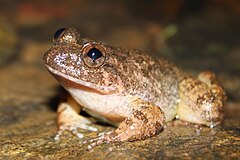Dicroglossidae
Wygląd
| Dicroglossidae[1] | |||||
| Anderson, 1871[2] | |||||
 Przedstawiciel rodziny – Quasipaa exilispinosa | |||||
| Systematyka | |||||
| Domena | |||||
|---|---|---|---|---|---|
| Królestwo | |||||
| Typ | |||||
| Podtyp | |||||
| Infratyp | |||||
| Nadgromada | |||||
| Gromada | |||||
| Podgromada | |||||
| Rząd | |||||
| Rodzina |
Dicroglossidae | ||||
| Typ nomenklatoryczny | |||||
|
Dicroglossus Günther, 1860 | |||||
| |||||
| Podrodziny | |||||
|
| |||||
Dicroglossidae – rodzina płazów z rzędu płazów bezogonowych (Anura).
Zasięg występowania
[edytuj | edytuj kod]Płazy z tej rodziny występują w tropikalnych oraz subtropikalnych rejonach Azji i Afryki. Większość gatunków należąca do tej rodziny żyje na terenie Azji[12]
Systematyka
[edytuj | edytuj kod]Początkowo Dicroglossidae była uznawana za podrodzinę rodziny żabowatych, jednak obecnie Dicroglossidae jest powszechnie uznawana za rodzinę[12][13].
Podział systematyczny
[edytuj | edytuj kod]Do rodziny należą następujące podrodziny[14]:
Galeria
[edytuj | edytuj kod]Uwagi
[edytuj | edytuj kod]- ↑ Rodzaj typowy: Occidozyga Kuhl & Van Hasselt, 1822.
- ↑ Rodzaj typowy: Paa Dubois, 1975 (= Nanorana Günther, 1896).
- ↑ Rodzaj typowy: Limnonectes Fitzinger, 1843.
- ↑ Rodzaj typowy: Annandia Dubois, 1992 (= Quasipaa Dubois, 1992).
- ↑ Rodzaj typowy: Hoplobatrachus Peters, 1863.
- ↑ Rodzaj typowy: Ingerana Dubois, 1986.
- ↑ Rodzaj typowy: Nannophrys Günther, 1869.
- ↑ Rodzaj typowy: Quasipaa Dubois, 1992.
Przypisy
[edytuj | edytuj kod]- ↑ Dicroglossidae, [w:] Integrated Taxonomic Information System (ang.).
- ↑ J. Anderson. A list of the reptilian accession to the Indian Museum, Calcutta from 1865 to 1870, with a description of some new species. „The Journal of the Asiatic Society of Bengal”. 40 (2), s. 38, 1871. (ang.).
- ↑ A. Dubois. Miscellanea taxinomica batrachologica (I). „Alytes”. 5, s. 57, 1987. (ang.).
- ↑ L. Fei, C.-y. Ye, Y.-z. Huang: (Key to Chinese Amphibians). Chongqing: Publishing House for Scientific and Technological Literature, 1990, s. 123. (chiń.).
- ↑ Dubois 1992 ↓, s. 313.
- ↑ Dubois 1992 ↓, s. 317.
- ↑ Dubois 1992 ↓, s. 315.
- ↑ A. Dubois, A. Ohler & S.D. Biju. A new genus and species of Ranidae (Amphibia, Anura) from south-western India. „Alytes”. 19 (2), s. 55, 2001. (ang.).
- ↑ A. Dubois. Amphibia Mundi. 1.1. An ergotaxonomy of Recent amphibians. „Alytes”. 23 (1), s. 16, 2005. (ang.).
- ↑ a b c d Fei, Ye i Jiang 2010 ↓, s. 19.
- ↑ Fei, Ye i Jiang 2010 ↓, s. 22.
- ↑ a b Dicroglossidae, [w:] Integrated Taxonomic Information System [dostęp 2015-08-01] (ang.).
- ↑ "Dicroglossidae". AmphibiaWeb: Information on amphibian biology and conservation.. AmphibiaWeb. [dostęp 2015-08-01]. (ang.).
- ↑ D. Frost: Dicroglossidae Anderson, 1871. [w:] Amphibian Species of the World 6.0, an Online Reference [on-line]. American Museum of Natural History. [dostęp 2020-01-01]. (ang.).
Bibliografia
[edytuj | edytuj kod]- A. Dubois. Notes sur la classification des Ranidae (Amphibiens anoures). „Bulletin Mensuel de la Société Linnéenne de Lyon”. 61, s. 305–352, 1992. (fr.).
- L. Fei, C.-y. Ye, J.-p. Jiang. Phylogenetic systematics of Ranidae. „Herpetologica Sinica”. 12, s. 1–43, 2010. (ang.).
- Sustainable Development of Delft Island: An ecological, socio-economic and archaeological assessment (IUCN)




